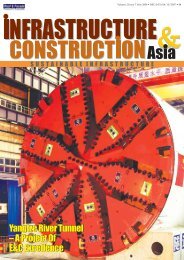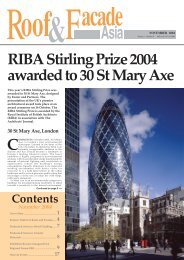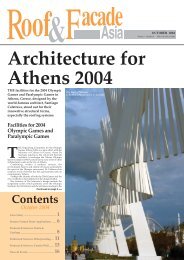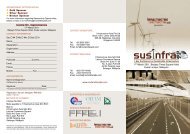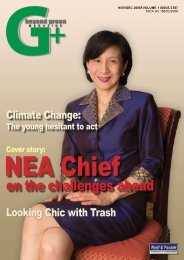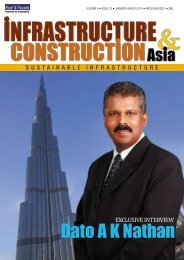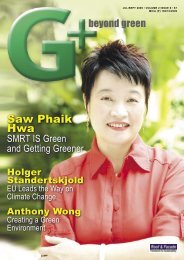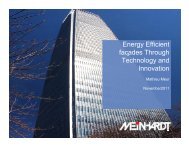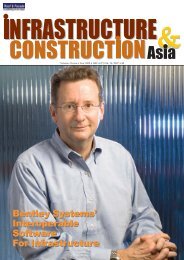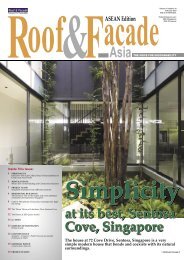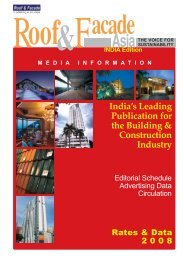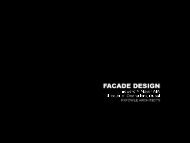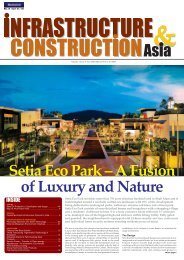ICA_Feb 07.pdf - Roof & Facade
ICA_Feb 07.pdf - Roof & Facade
ICA_Feb 07.pdf - Roof & Facade
Create successful ePaper yourself
Turn your PDF publications into a flip-book with our unique Google optimized e-Paper software.
Transportation<br />
The Advantages of Steel Fibre<br />
Reinforced Concrete (SFRC)<br />
The addition of steel fibres to concrete is an important step in research towards improving its properties. The<br />
areas of potential use are expanding. For example, steel fibres not only offer a solution for the low-tensile<br />
strength of concrete but give pseudo-ductile properties to brittle concrete. Finally, the steel fibres provide good<br />
energy-absorption which, in turn, offers a technical solution to certain specific loading conditions.<br />
FIBRE reinforced concrete is a composite material<br />
whose bearing strength is determined by the<br />
combination of its two constituent parts: the concrete<br />
and the fibres.<br />
P c<br />
= P m<br />
+ P f<br />
This assumes there is a close interaction between the<br />
two materials. Where a load is applied, this results in a<br />
deformation. Depending on the composite’s state of<br />
deformation of the composite, this interaction is<br />
governed by (1) the ratio between the elasticity moduli<br />
(n = E f<br />
/E m<br />
), (2) the transmission of the stress from the<br />
concrete to the fibres, and (3) the uniformity of<br />
distribution of the fibres.<br />
Steel fibres with hooked ends maximise these<br />
interaction fibres because the use of high-tensile drawn<br />
steel wire and the anchored hooked ends of the fibres,<br />
which make it possible to use the whole length of fibre<br />
to transmit the maximum amount of force and to<br />
prevent any splitting force from being exerted on the<br />
concrete. Furthermore, a uniform distribution of fibres<br />
in the concrete is obtained via the easy handling quality<br />
of steel fibre bundles.<br />
Reinforcement with steel fibres only show its full<br />
value in the post-elastic deformation phase. The sudden<br />
brittle failure of reinforced concrete is transformed into<br />
slow, controlled crack propagation under the influences<br />
of forces such as compression, tension, flexure, shear,<br />
shrinkage and creep. The intrinsic qualities of using<br />
steel fibres are fully revealed when they span hairline<br />
cracks in the concrete and absorb the tensile forces<br />
present. This process is related to the fibres’ hooks<br />
which are fixed in the concrete and continues until a<br />
high maximum pulling-out force is reached. To avoid<br />
sudden failure of the concrete, the quality of the steel is<br />
selected so that the breaking strength of the fibres is<br />
only exceeded in exceptional cases.<br />
In the case of further loading, the width of the crack<br />
will increase due to the pulling-out of the fibre as the<br />
hooks of the fibre undergo plastic deformation. This<br />
plastic deformation under high tensile stresses is one<br />
of the principle characteristics of steel fibres, and it<br />
allows the steel fibre concrete to achieve a high degree<br />
of toughness (ductility).<br />
As applied to concrete tunnel linings, worldrenowned<br />
expert on the subject of steel fibre reinforced<br />
concrete Mr Ir. Marc Vandewalle stated in a presentation<br />
in Singapore in 2006 sponsored by The Institute of<br />
Engineers Australia that the technical advantages of<br />
using steel fibre reinforced concrete (SFRC) include<br />
homogenous distribution, multidirectional reinforcement,<br />
excellent corrosion resistance, high-impact<br />
resistance and excellent control of shrinkage cracks, thus<br />
allowing for a more cost-effective and environmentallyfriendly<br />
engineering solution than using the standard<br />
reinforcement-cage alternative. ❏<br />
About the Company<br />
BEKAERT began as a small manufacturing<br />
and trading company founded by Leo Leander<br />
Bekaert in 1880 in the city of Zwevegem,<br />
Belgium, which is still home to Bekaert’s head<br />
office. Over the years, the company has grown<br />
into an international wire and wire-related<br />
products company, with manufacturing facilities<br />
in Europe, North and South America, Asia, and<br />
offices all over the world.<br />
Bekaert employs close to 18,000 people<br />
worldwide and has an annual sales volume of<br />
nearly US$3 billion. Because there is still a strong<br />
need for manufactured goods, particularly wire<br />
products, Bekaert is expanding every year with<br />
new products and technology to keep up with<br />
world demand.<br />
As a world leader in advanced metal<br />
transformation and advanced materials and<br />
coatings, Bekaert is also known in the concrete<br />
industry as the manufacturer of premiumquality,<br />
cold-drawn, hooked-end steel fibres<br />
under the trade name Dramix ® which turns<br />
concrete (a normally brittle material) into a<br />
ductile one when added to a concrete mix. ❏<br />
SFRC segmented tunnel linings<br />
6 <strong>ICA</strong> Volume 1 Issue 1 2007




